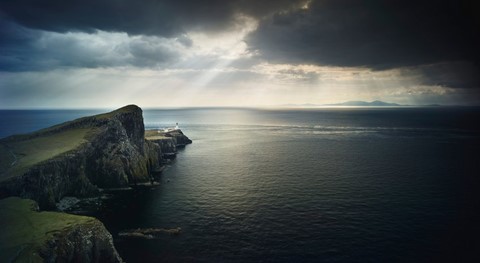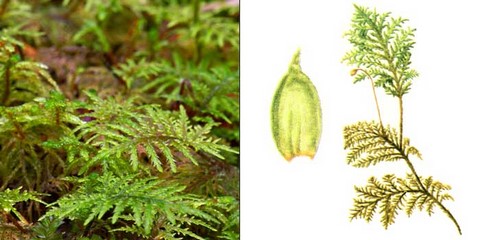Moss betrays the season of the Störegga event
Doggerland died at the end of Fall
It would have been a busy Summer. Daily, Northern Europeans went hunting so as to provide plenty of meat and fruit for the long winter and build up supplies. In October they finally retired to their dwellings in the milder coastal plains, where they felt secure.
Yet on one autumn day about 8150 years ago – the men of the Mesolithic had just repaired to their winter quarters – one of the greatest catastrophes in the European past crashed down upon them. For the first time, scientists are now able to tell the whole story.
In the Northern Atlantic, before the coast of Norway, at the height of Bergen and Trondheim, masses of underwater sea-mud of a size larger than the whole of Iceland slipped off, sliding from the shallow coastal waters into the depth of the North Sea. Like a stone thrown into a puddle, the so-called Störegga landslide created waves which spread in circles at the speed of a jet airplane. A short time later, monster waves broke against the coastlines, towering at 20 meters – and the water rushed inland over dozens of kilometres.

In many places, archaeologists found traces of the catastrophe: in the East of Scotland, near Inverness, the wave surprised people by a camp fire, as shown by a 25cm layer of sand and gravel ten meters above sea level. Remains of urchins, sea mussels and seaweed testify to the rush of water which carried everything along. In Norway, on the Shetland Islands, and the Faroe Islands, traces of devastation lay even higher above the sea level of that time, waves above 20m crashed onto the land. The age of the desposits yielded a consistant value of 8,150 years.
But worst hit by the waves was the “old heart of Europe:” between Great-Britain and Germany, on today’s bottom of the North Sea, there was Doggerland, a kind of Mesolithic paradise. Hundreds of finds of stone tools, harpoons and human bones from the bottom of the North Sea testify to the settlements there, which archaeologists came to describe as a “Garden of Eden,” as “the true heart of Europe.” One could go on foot from today’s Northern Germany to Great Britain.
Then came the tsumanis. It is possible that Doggerland was at once completely overwhelmed, geologists discovered recently. Vast amounts of the sandy soil were carried away by the waves. The Stoeregga slide was quite possibly the cause of the end of settlement history on Doggerland.
In the other parts of Northern Europe as well, the effects of the tsunamis were more devastating than had been thought before. Knut Rydgren and Stein Bondevik of Sogn og Fjordane University in Sogn, Norway, studied remains of plants from the catastrophe areas. The tsunamis came at the worst possible time, as the researchers are now revealing in the scientific journal Geology.

The decisive clues for the mesolithic mass death are mosses, especially Hylocomium splendens, known today as glittering wood-moss, or mountain fern moss. After the tsunamis of 8,150 years ago, they were buried under sea mud so that they remained sealed up and preserved. The state of growth they have been found in reveals at what season the monster waves hit.
Every Spring fresh new green shoots of Hylocomium splendens appear, which branch out every subsequent month. The mosses in the destroyed Mesolithic settlements betray the fact that they were buried in late fall, Rydgren and Bondevik report. A distressing inference: “the stone age hunters must have all returned to the coasts by then,” write the geologists. “Therefore the tsunamis must have caught most of the people off-guard, it must have been terrible.”
The survivers had a hard winter before them. “The loss of their reserves, tools and dwellings must have been a grave problem for them.” Write Rydgren and Bondevik. "Many probably didn’t make it through the winter."
Axel Bojanowski
Translated and adapted from the German by Anne-Marie de Grazia
Original article, Der Spiegel, January 13, 2015.
Abstract of article in "Geology"
Moss growth patterns and timing of human exposure to a Mesolithic tsunami in the North Atlantic
Knut Rydgren and Stein Bondevik
Faculty of Engineering and Science, Sogn og Fjordane University College, P.O. Box 133, N-6851 Sogndal, Norway
Abstract
The Storegga tsunami, triggered ∼8150 yr ago by one of the largest submarine slides on Earth, flooded margins of the North Sea and the Norwegian Sea that were occupied by Mesolithic peoples. Sand deposits of Storegga age overlie the remains of coastal settlements in Norway and Scotland. The resulting casualties, however, depend on the season when the tsunami struck. Human exposure would have been least in summer and early autumn, when Mesolithic peoples went to the mountains to hunt reindeer. The hunters returned to the coast in late autumn to settle into their winter quarters. Here we use moss stems to show that the Storegga tsunami happened in late autumn. The Storegga tsunami deposits contain samples of the moss Hylocomium splendens. Some of these stems retain green color and chlorophyll that imply burial alive. H. splendens has a characteristic growth cycle where new segments branch off from previous year's growth. The Storegga mosses have segments more mature than those of modern July and August samples, but as mature as those from October through December. The enormous Storegga tsunami thus occurred late enough in the year to have reached a large fraction of the people then inhabiting western Norway and northeast Scotland. For those who survived the tsunami, the loss and destruction of dwellings, boats, equipment, and supplies must have made the following winter very difficult.
Link to article in "Geology" magazine

